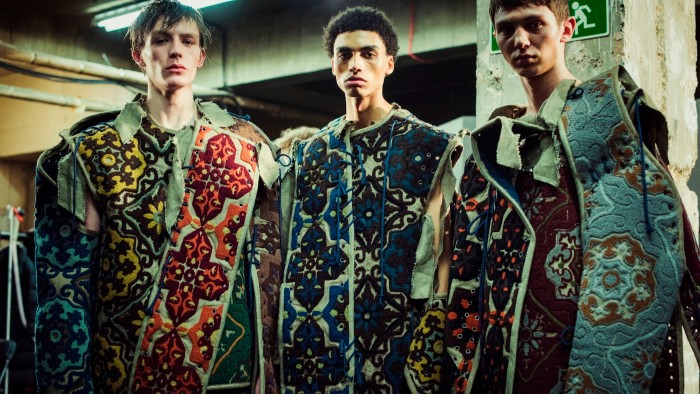Our Terms & Conditions | Our Privacy Policy
‘A woman’s role was to decorate the house’
Unlock the Editor’s Digest for free
Roula Khalaf, Editor of the FT, selects her favourite stories in this weekly newsletter.
In the 19th century, the clothing of upper- and middle-class women merged with their home decor. Both were literally heavy, rich in detail and saccharine-pretty — a theme explored in Fashion & Interiors. A Gendered Affair, an exhibition opening at MoMu in Antwerp next weekend.
“A woman’s role was to decorate the house,” says curator Romy Cocx. “Men went out to work and women stayed home, surrounded by an overload of fabrics, developing the status of the family.”
The show explores the pressures women of that period faced, and how modernism in interiors propelled new, easy-to-wear, less gendered fashion.
 Alfred Stevens ‘The Visit’ © Dallas Museum of Art, gift of the Pauline Allen Gill Foundation/Image courtesy Dallas Museum of Art
Alfred Stevens ‘The Visit’ © Dallas Museum of Art, gift of the Pauline Allen Gill Foundation/Image courtesy Dallas Museum of Art
There are sections looking at fashion designers who have worked or began their careers in interiors. Raf Simons’ 1991 graduate collection, Corpo, presented seven pieces of furniture wrapped and clothed in textiles. It was four years before he moved into fashion proper, but he has repeatedly gone back to his roots. He used his own complicated coloured weave of Kvadrat upholstery fabric for clothes at Jil Sander, while garments from his tenure at Calvin Klein used trad American quilting and were matched by a set of Cassina Feltri chairs covered in the same fabrics.
The recent Prada show makes the exhibition feel extra timely. In Milan, the brand laid a blue deco floral carpet by set designer Catherine Martin — a retro, tufted floor covering that presented the narrative of Miuccia Prada and co-designer Simons’ exploration of modern femininity in shorthand. Over the carpet unkempt models walked in dresses and jackets that were purposely awkward in their fit, making them look like unnerving Cindy Sherman housewives. Pretty in pink it wasn’t.
 Calvin Klein AW 2018 © Catwalk Pictures
Calvin Klein AW 2018 © Catwalk Pictures Marine Serre AW 2020 © Catwalk Pictures
Marine Serre AW 2020 © Catwalk Pictures
As the show underlines, 19th-century dress codes were restrictive for all. Although it is womenswear that has been liberated most by modernism, there has been a relaxation in the approach to gender overall.
“I struggle with opulence and lack of practicality,” says Erica Toogood, who names the functional garments she designs for Toogood after a variety of professions (baker, painter, potter). “My leaning as a designer is to pull the humble material upwards to elevate, rather than drawing the elevated down to everyday functional garments. I use fashion textiles at home. I want my curtains to look like me, not the other way around.”
 Maison Martin Margiela AW 1999 © MoMu Antwerp/Stany Dederen
Maison Martin Margiela AW 1999 © MoMu Antwerp/Stany Dederen Viktor & Rolf SS 2005 © Catwalk Pictures
Viktor & Rolf SS 2005 © Catwalk Pictures
Other women in fashion live the way they dress and dress others. For decades Ann Demeulemeester lived in the only Le Corbusier house in Antwerp, which felt apposite for a designer whose work is less about gender, more about uniform. The Antwerp show also explores the influence of Adolf Loos — as much a theorist on clothing and aesthetics as he was an arch modernist against ornamentation — and Martin Margiela, who, explains Cocx, “created a total approach, with white paint and fabrics covering clothes and interiors, similar to Le Corbusier, who whitewashed everything for a new beginning. Margiela is also notable for the duvet coat from 2000, which addresses the fragility of the 19th-century idea of home.”
Interiors trends come and go, but today things are generally getting lighter, simpler (and cheaper), just as they are with mainstream fashion. But couture designers still go big and go home to make a statement. Last year, British designer Giles Deacon launched a range of upholstery fabrics with Sanderson. To mark the occasion, he designed a broad-cuffed dress, made from striped Regency Aperigon with a bronze sheen, for his life partner, the actor Gwendoline Christie. “It’s about subverting the elegance, refinement and theatricality of those textiles,” he explains. “I am reimagining interiors for couture gowns. It creates a starting point for a narrative.”
And that narrative can go anywhere. As Cocx says: “We don’t have to live in an environment dictated by society now. It’s about what makes you feel good. And that’s about not following fashion. It’s just about you.”
‘Fashion & Interiors. A Gendered Affair’ is at MoMu from March 29 to August 3
Follow us on Instagram and sign up for Fashion Matters, your weekly newsletter about the fashion industry
[ad_1]
Images are for reference only.Images and contents gathered automatic from google or 3rd party sources.All rights on the images and contents are with their legal original owners.
[ad_2]



Comments are closed.